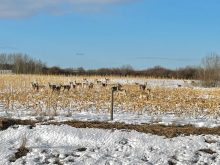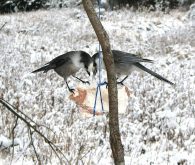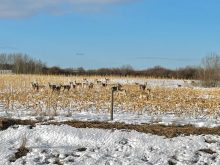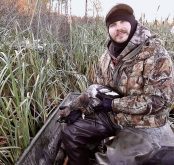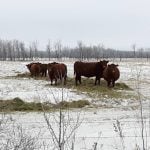Manitoba’s elk producers say they’re generally happy with measures to control chronic wasting disease (CWD) following a second case in wild mule deer earlier this month, although they say the geographic spread of cases is cause for concern.
“We are impressed and pleased with the vigour and aggressiveness of (the province’s) actions and I certainly hope they’re successful,” Manitoba Elk Growers Association president Ian Thorleifson said.
At the same time, he said, they are discouraged that the province’s second and most recent CWD case was discovered near the Canada-U.S. border, hundreds of kilometres southwest of the initial case in Manitoba’s Parkland.
Read Also

Beekeepers want financial protection against tropi mite
What happens to beekeepers if the deadly tropi mite reaches Canada? Discover why farmers want robust compensation to protect pollination.
“It’s an indication that there’s probably more in the province than we are aware of, and I suppose that we’re less hopeful that we’re going to stop it,” he said.
Why it matters: A prion disease in the same family as BSE, CWD causes incurable neural degradation and death in cervids like deer, elk and moose.
Manitoba’s luck on CWD ran out in mid-October this year, when a visibly ill male mule deer near Lake of the Prairies was euthanized. On Nov. 1, the province announced the animal was Manitoba’s first confirmed case of CWD.
The finding was met with disappointment, but not surprise, from hunters and farmers, who had long noted Saskatchewan’s troubles with CWD and the prevalence of the illness in that province’s wild deer populations. Manitoba had likely been on borrowed time, and the elk producers’ association had long pushed for mule deer control in Manitoba.
Prior to the finding, the province had allowed no hunting of mule deer, with the exception of Indigenous hunters, as they are a protected species.
Any hopes that the first finding was an isolated incident were dashed Dec. 10, when the province announced a second CWD case, this one in the extreme southwestern corner of the province, again in a mule deer.
Control measures
Following the first finding in northwest Manitoba, the province immediately instituted a 10-kilometre control zone around the case.
A hunting ban was also introduced. The province argued that it was critical to control carcass movement during those first days, since the prions causing CWD can survive in a deer carcass and be accidentally spread.
Once control of the area was secured, the province opened up deer hunting for a limited two-week season for local hunters. Manitoba’s Chief Veterinary Officer Dr. Scott Zaari, said about 150 permits were requested.
Mandatory CWD testing was implemented for any cervid taken out of that zone. Much of the control zone was already within Manitoba’s CWD hunter surveillance area, a strip stretching the length of the Saskatchewan border until just south of Flin Flon and bulging out around Riding Mountain National Park. The province has long required any deer taken out of that surveillance area to be tested for CWD.
“This approach was staged,” Zaari said. “It wasn’t any regulatory hammer of government coming in and saying, ‘thou shalt do this.’ This is two weeks of door-to-door consultation between the wildlife and fisheries branch team and landowners.”
The province is now working to depopulate mule deer in the control zone. Talks with landowners have granted the team access to the majority of required land, Zaari noted. The goal, he says, is to draw the population down as much as possible.
Tests both from the limited hunting season and mule deer depopulation will give context on how far and deeply the disease has spread into the area.
“We do not know the history of that mule deer in terms of its movements, so we base what we know in terms of the host range of a mule deer, and that’s what created our 10-kilometre buffer area,” Zaari said. “In that, we can only assume at this point, until we know more from testing, that other animals would have been exposed in that area.”
Increased scrutiny is also on the region around the second finding. Zaari says his office is currently engaged in tracking and ensuring that they receive any hunter samples out of that area for testing.
Most of the attention so far, however, has been on the first case in the northwest.
“The reality is that we’ve got all of our resources committed to Case 1, and once the operational aspects of that are complete, yes, we will be moving over to Case 2,” he said. “Of course, it starts with us understanding what’s going on in that area, so we’ll likely replicate similar things like initiating hunter-collected samples.”
Decisions on control measures will be made from there, he said, and may or may not look similar to what’s happening now around Lake of the Prairies.
Zaari expects that switch in focus before the end of the year.
Chris Heald, executive director of the Manitoba Wildlife Federation, says they have been consulting with the province on the measures.
“We’ve been double-checking with other jurisdictions and disease experts and different veterinarians and definitely the province is on the right track here (with) the cull,” he said.
He noted, however, that the organization would have liked to see mule deer control earlier, given the disease risk.
The federation has been receiving regular updates from the province and relaying them to its hunting members, he noted.
“Hunters will play an important part going forward once they have the sampling size done and find out what the disease spread is, if any,” Heald said.
Producers’ perspective
The second finding, and its location, means producers should assume that Manitoba is endemic with CWD when planning management, Thorleifson said.
That will mean little operational change for farmers raising elk for meat, he added, noting that biosecurity, good genetics, extensive herd records and testing requirements have long been in place already in the elk sector.
It is unclear, however, how much of a hit Manitoba’s elk sector will take on animals exported for trophy next year.
Certain U.S. states close the door to animals from a CWD-positive area, the elk sector has noted. CWD findings dodged the peak season for that corner of the industry this year, Thorleifson said, since bulls are moved when they are in hard antler in August.
The elk sector also has hopeful eyes on the University of Saskatchewan’s vaccine and infectious disease research centre, VIDO-InterVac, which in 2010 signed an agreement to develop a vaccine for CWD.
Longer term
Zaari also noted that the issue will stretch long past the initial control and depopulation measures. A long-term management strategy will be needed, he said, including conversations with the province of Saskatchewan.
“It isn’t all about deer depopulation,” he said. “There’s other avenues that we will take to make sure that we can maintain a long-term strategy beyond just being actively responsive to cases.”




